13 transitional kitchen ideas that effortlessly blend old and new
Create transitional kitchens that beautifully balance old and new with these design ideas and expert tips

Pippa Blenkinsop

- 1. Blend historic details with modern functionality
- 2. Mix rustic wood details with sleek white cabinetry
- 3. Choose classic Shaker-style cabinetry
- 4. Incorporate plenty of natural materials
- 5. Give classic cabinetry a modern feel with simple hardware
- 6. Add a rustic feel with handmade tiles
- 7. Mix in freestanding antique furniture
- 8. Add vintage lighting
- 9. Paint cabinets to bring modernity to a classic kitchen
- 10. Style a sleek kitchen with vintage accessories
- 11. Consider your flooring choice
- 12. Mix in old fashioned features
- 13. Soften a modern kitchen with warm brass tones
- What is a transitional kitchen?
- What colors work best in a transitional kitchen?
Kitchens are a big investment in our homes, both in time and money, so designing a space that feels timeless is at the top of almost everybody's list. And if there's one style that feels like the perfect fit, it's transitional kitchens.
Offering a seamless blend of traditional and modern features, it's a design approach that will ensure your kitchen ideas stand the test of time. When transitional design is done right, your kitchen will always feel in style, while allowing plenty of opportunity for personalization.
But how do you nail the perfect balance of classic features with more contemporary additions? We've turned to designers to find out how they introduce transitional style to a kitchen – and there's plenty here to inspire.
13 transitional kitchen ideas that offer the perfect balance of modern and traditional
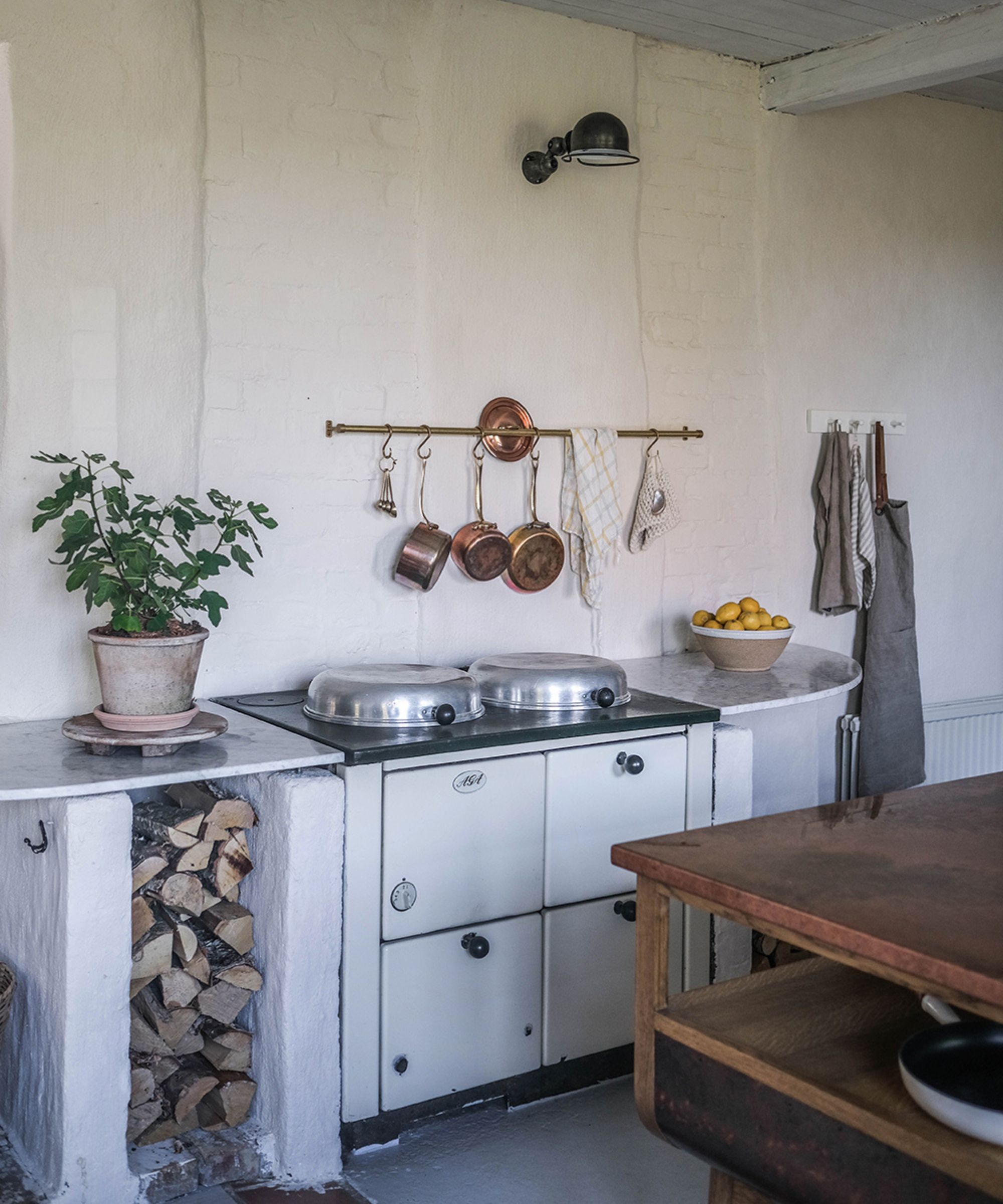
'The transitional kitchen is all about restraint. It’s grounded in tradition but stripped of anything fussy. That balance between classical form and modern clarity is what makes it feel unmistakably fresh and warm,' says interior designer Christopher Boutlier, who often designs spaces in this style.
From colors and materials to styles and decor, here's everything you need to know about designing a transitional kitchen and the best features to introduce for a timeless kitchen.
1. Blend historic details with modern functionality
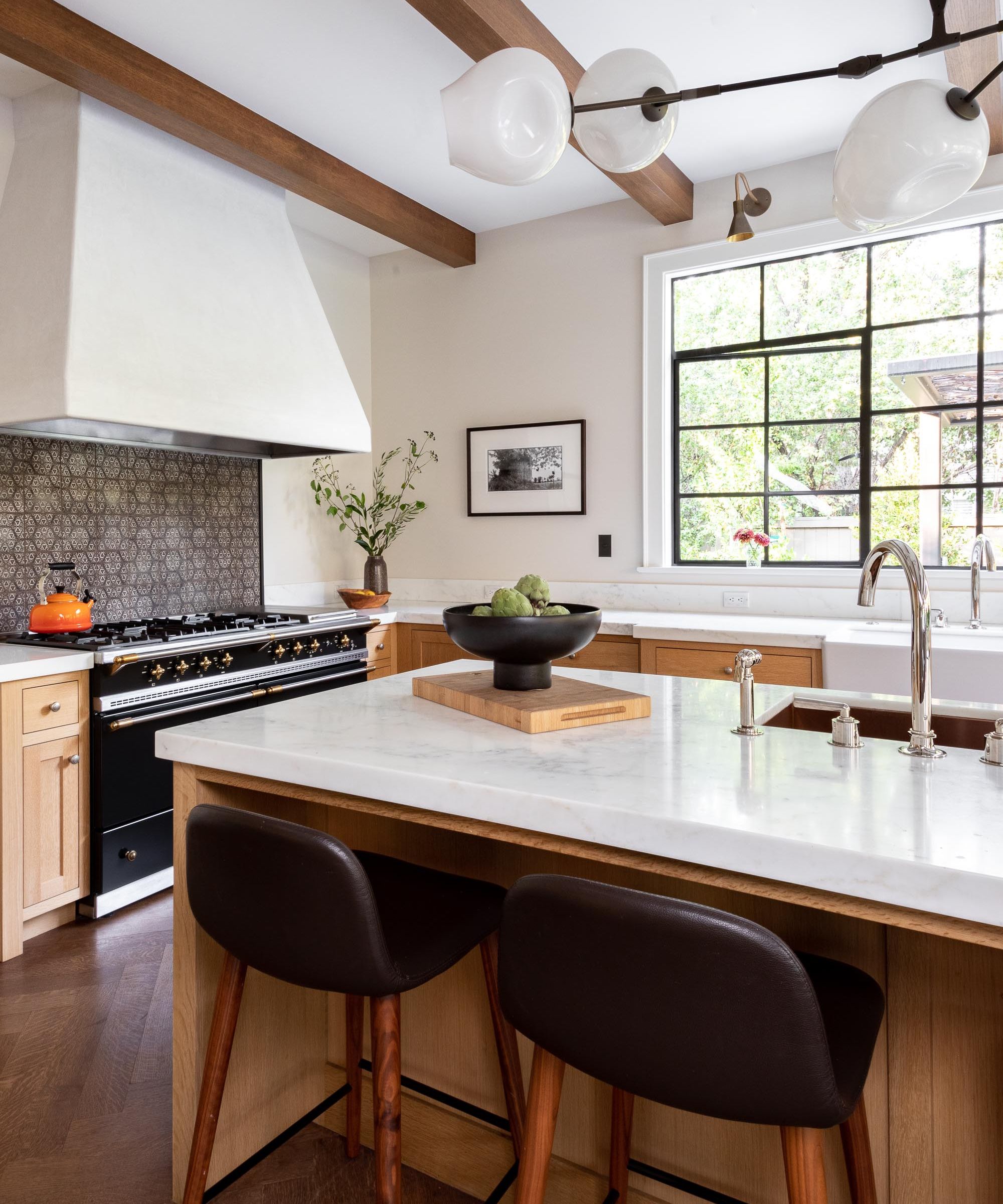
Transitional kitchens really come into their own in period properties, where historic details combine with more contemporary features for a design that honors the old while embracing the new, like in this space.
'This is a classic California shingle house, and we wanted to honor that history while also updating elements for modern functionality. The inset oak cabinets speak to early craftsman details, while the stove brings a sense of vintage charm,' explains interior designer Erin Williamson.
Design expertise in your inbox – from inspiring decorating ideas and beautiful celebrity homes to practical gardening advice and shopping round-ups.
'Throughout the kitchen, we streamlined visual clutter to a minimum by maintaining clean lines and eschewing upper cabinets in favor of artwork. The overall effect is a sense of casual ease appropriate for a family gathering space.'
2. Mix rustic wood details with sleek white cabinetry
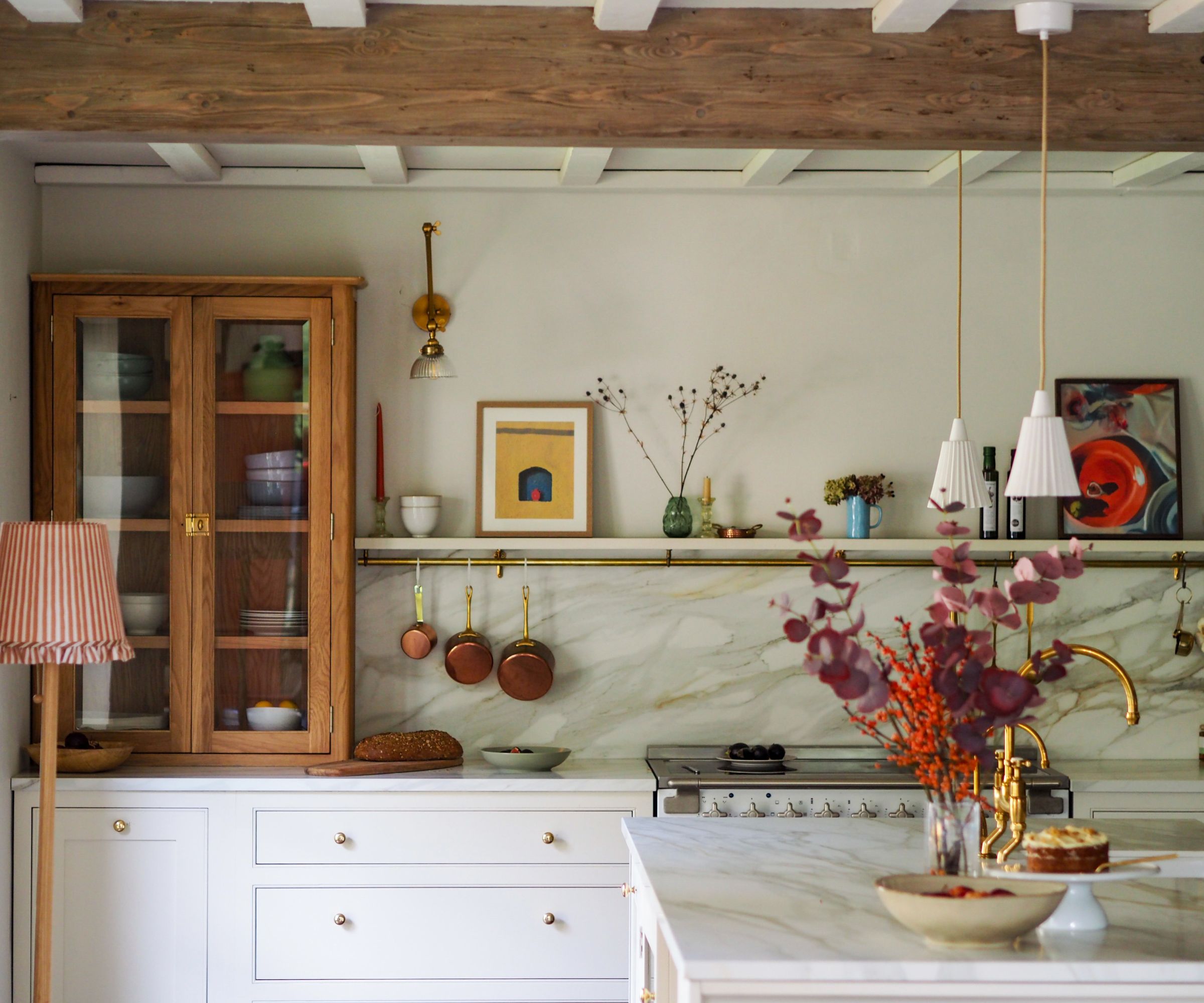
Add character to contemporary kitchen cabinets by pairing them with rustic wood accents, like the countertop cabinets added to this kitchen. Not only do they add a beautiful contrast to the white built-ins, but they also tie in the original ceiling beams.
The space has been elevated further with the addition of the open shelving, used to display personal decor and more visually pleasing kitchenware. It's the perfect balance of sleek design and lived-in style, the epitome of a transitional kitchen.
3. Choose classic Shaker-style cabinetry

For a timeless kitchen you can’t go wrong with classic Shaker-style kitchen cabinets in a neutral color. Characterized by a simple frame and panel door of pleasing proportions, the Shaker kitchen style takes its name from the Shaker community that came to America from England in the 18th century. The Shaker furniture makers followed principles of purity, honesty and simplicity in design and rejected ornamentation in favor of utility.
Made from solid timber, Shaker doors will stand the test of time and can be repainted as and when tastes change. Emily Ruff, founder and principal designer at Cohesively Curated, chose the style to create the perfect new-old look in this 1920s home.
‘Our goal here was to make the kitchen feel like it belonged in a historical home, but was fresh and bright for this young growing family,’ says Emily Ruff. 'The home was built in the 1920s and my client loved classic British kitchens that have inset cabinets with shaker details on the doors, but all flat drawers.'
'We added some fluted details to the inside panels of the shaker doors on the coffee bar cabinets to create visual interest. For the finish we selected Agreeable Gray from Sherwin Williams. It is a very light gray with warm undertones so it still feels fresh and bright.'
4. Incorporate plenty of natural materials
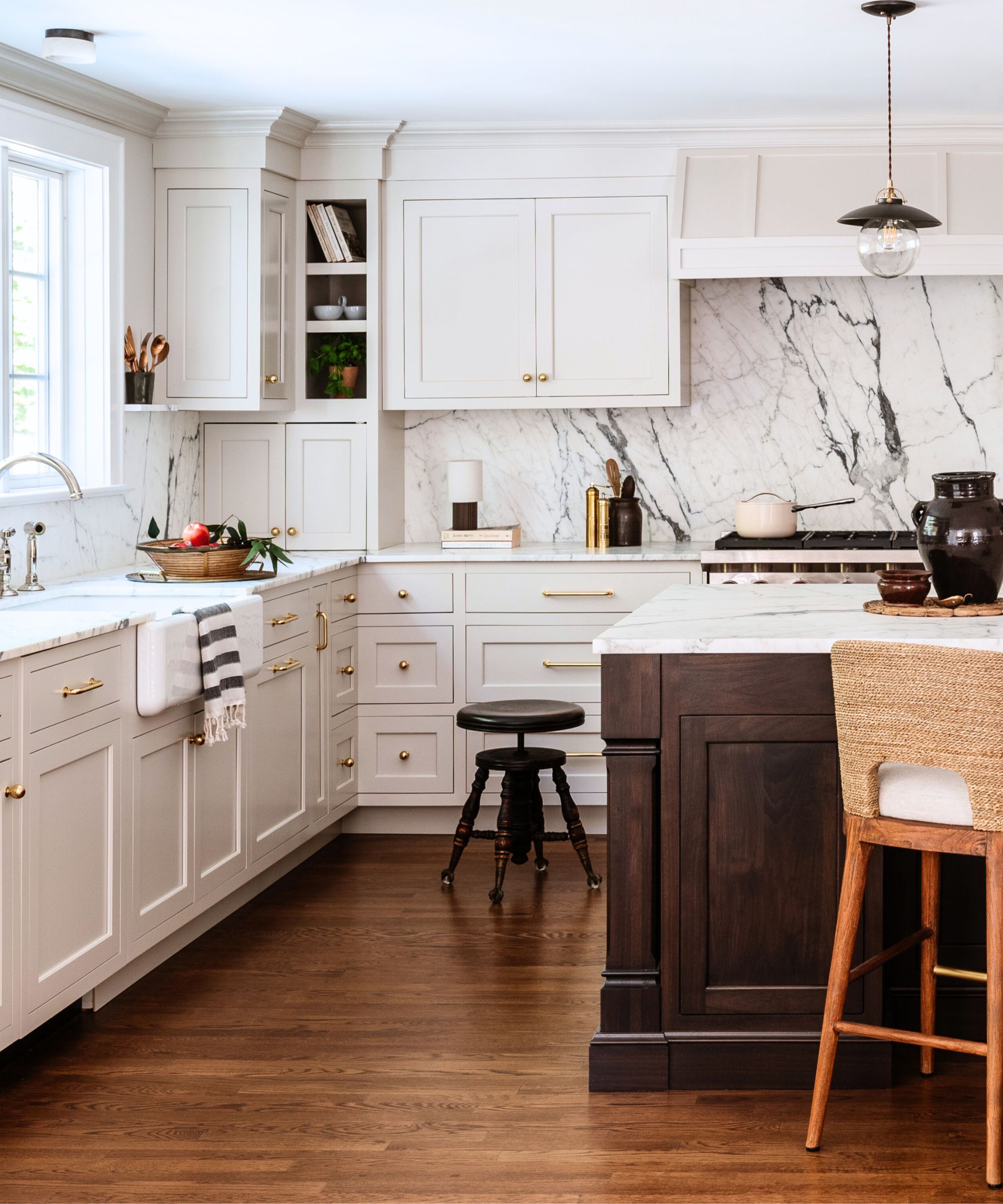
Wood and stone have an enduring charm that never goes out of style, so for a timeless transitional space you can’t go wrong by incorporating these natural materials into your kitchen design. White kitchens can have a tendency to feel cold and stark, but incorporating natural materials helps bring instant softness and a relaxed, aged feel, as demonstrated in this beautiful space by Colette Interiors.
‘We paired rich, warm wood tones, with authentic stone, classic fixtures, and traditional profiles to provide this kitchen with a timeless aesthetic,’ explains Trish Lynn, founder and principal designer at Colette Interiors. ‘Our approach to layering in vintage elements with modern finishes helped to lend itself to this old-meets-new, transitional vibe.’
5. Give classic cabinetry a modern feel with simple hardware

Upgrading hardware is an easy way to dial up a classic neutral kitchen without adding extra color. Here, the team at Herlong Architecture and Interiors based in Charleston, have given a classic Shaker-inspired kitchen a modern edge with sleek black hardware.
‘The homeowners wanted a clean classic kitchen with a touch of modern, including accents of black contrasting light fixtures, cabinet hardware and a glossy tile kitchen backsplash. They were after a high contrast look, while still keeping in tune with a coastal design as they live on the marsh with a beautiful water view,’ says Heather Allison, interior designer at Herlong Architects and Interiors.
6. Add a rustic feel with handmade tiles
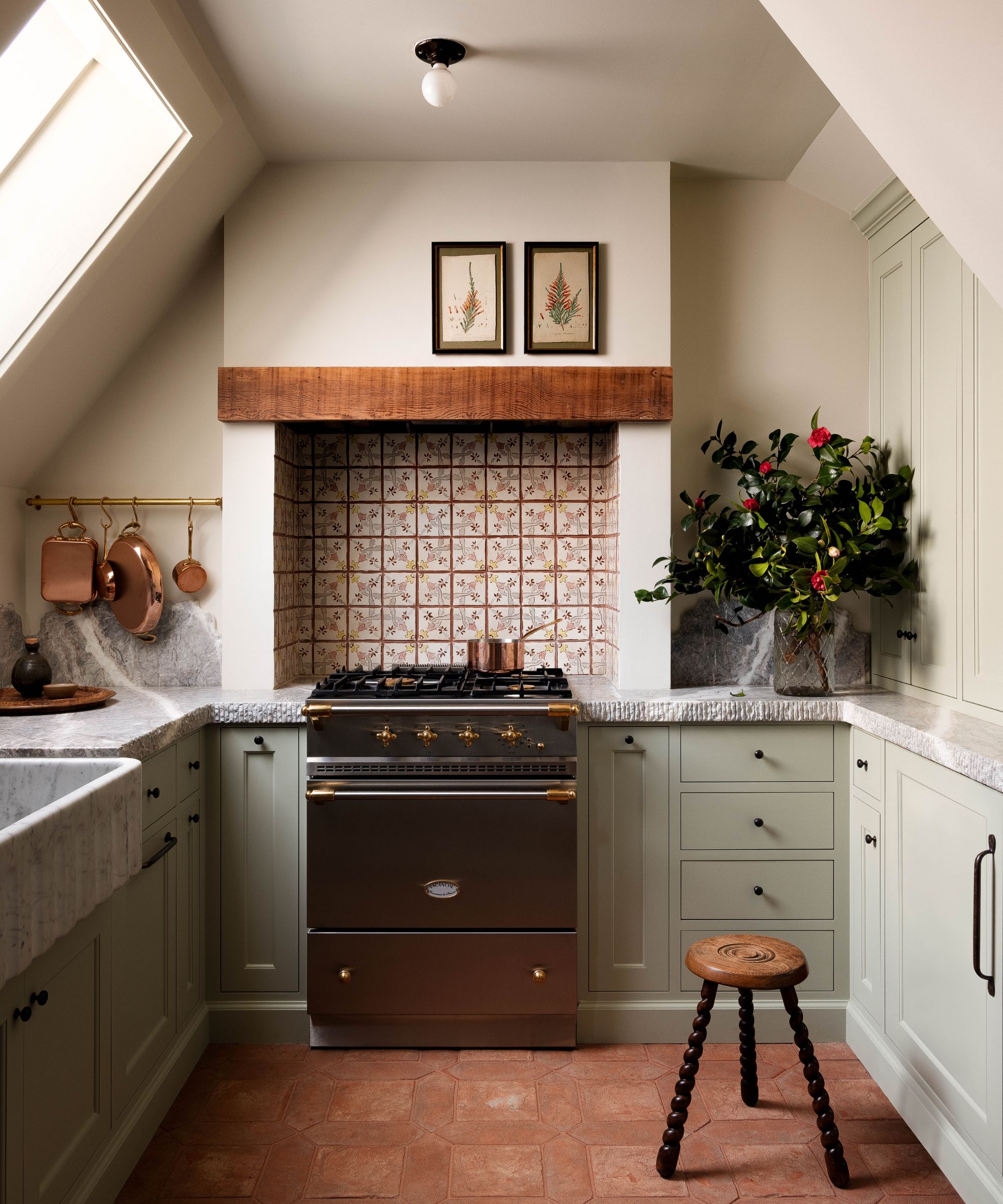
Boasting beautiful, varied textures, handmade tiles make a wonderful way to bring instant character to kitchen floors and splashbacks. Here, interior designer Heidi Caillier chose a mix of handcrafted terracotta kitchen floor tiles with hand-painted tiles above the oven to bring a touch of rustic European charm to this San Francisco pied-à-terre. Although not old, the handcrafted tiles have an aged quality that brings a relaxed, lived-in look to the space.
7. Mix in freestanding antique furniture
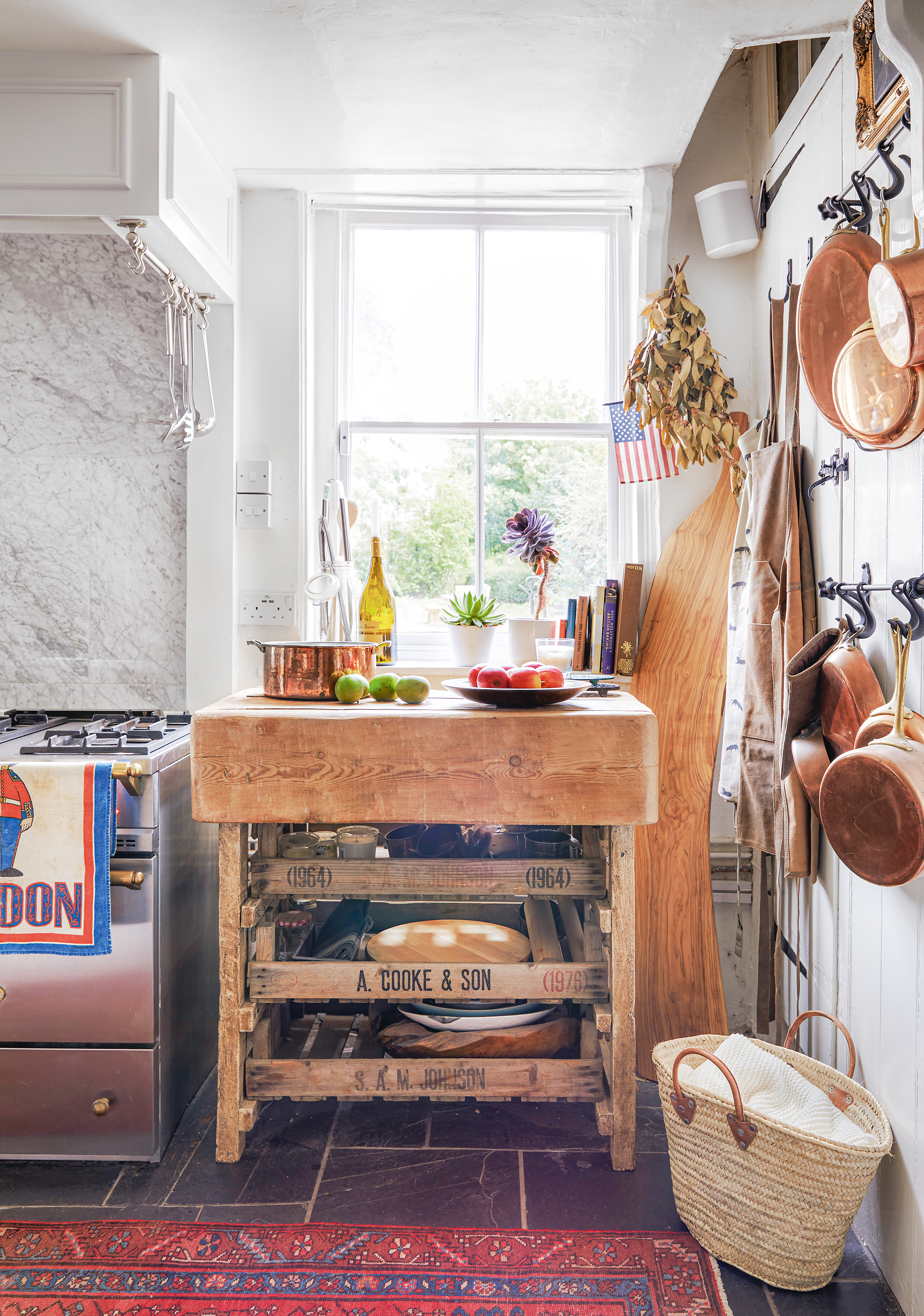
If you love the vintage kitchen look, mixing built-in cabinetry with antique freestanding kitchen ideas is a wonderful way to bring character. Plus, freestanding kitchens have multiple functional benefits. Easily picked up from online marketplaces, boot sales, and flea fairs, antique furniture brings flexibility to the layout as it can easily be moved, plus you can also bring it with you should you move house.
‘Kitchens need to be functional, so having new cabinetry that is well organized and functions well (glides and hardware that operate smoothly), appliances, and new plumbing fixtures, are all important to helping with function. That said, there are ways to bring in patina to new kitchens; there are some really cool old butcher's block tables or pastry work tables that can be used as an island,' says interior designer Allison Babcock.
'Incorporate antique and vintage furniture and accessories. An antique kitchen table and chairs, vintage dough bowls used as fruit and vegetable containers, cutting boards, and vintage glassware all can add patina to a new kitchen.'
8. Add vintage lighting

Adding character with vintage kitchen lighting is a subtle way to create a transitional kitchen, as they can easily be switched should tastes change. With its shaker-style cabinetry, this white kitchen by Allison Babcock is guaranteed to endure across the decades while the oversized vintage ceiling pendants bring a unique twist.
‘Antique lighting is a fun way to bring in patina. I love finding interesting and one-of-a-kind lighting fixtures and having them rewired to use above an island,’ says Allison.
9. Paint cabinets to bring modernity to a classic kitchen

Opting for a kitchen with traditional painted kitchen cabinets in a vibrant, head-turning color makes a fun juxtaposition that's spot on for a transitional kitchen.
‘My favorite kitchens seem to have a perfect blend of old and new elements that really feel timeless,’ says New York City-based interior designer Phillip Thomas. ‘Adding a fresh new punch of color to cabinets or incorporating a bold metal accent like a shiny brass hood, mixed with your grandmother's china and your favorite vintage stools found at an estate sale, are a fun way to balance a classic kitchen space.’
Some colors to consider – Farrow & Ball's Pea Flower Tea, Benjamin Moore's Blushing Red and for a really vibrant but soft green shade, try Sherwin-Williams Courtyard.
10. Style a sleek kitchen with vintage accessories

Styling a modern kitchen with antique and vintage pieces will bring instant rustic charm and create more of a transitional feel. Items like old chopping boards, French confit pots, and old wooden apple crates bring warmth and texture and are easy to pick up and flea fairs and boot sales.
When it comes to styling kitchen shelves, 'I like to use contrasting textures, for example, reflective glass against a raffia bottle or a rough pottery vase to make the items stand out,' says interior designer Julia Dempster. 'I love the rough textures on antique chopping boards; they work well displayed vertically. Concealed recessed lighting in shelves can throw illumination on the beautifully curated items – one of my favorite things to do in a transitional kitchen as it adds an extra dimension to the interior.'
11. Consider your flooring choice
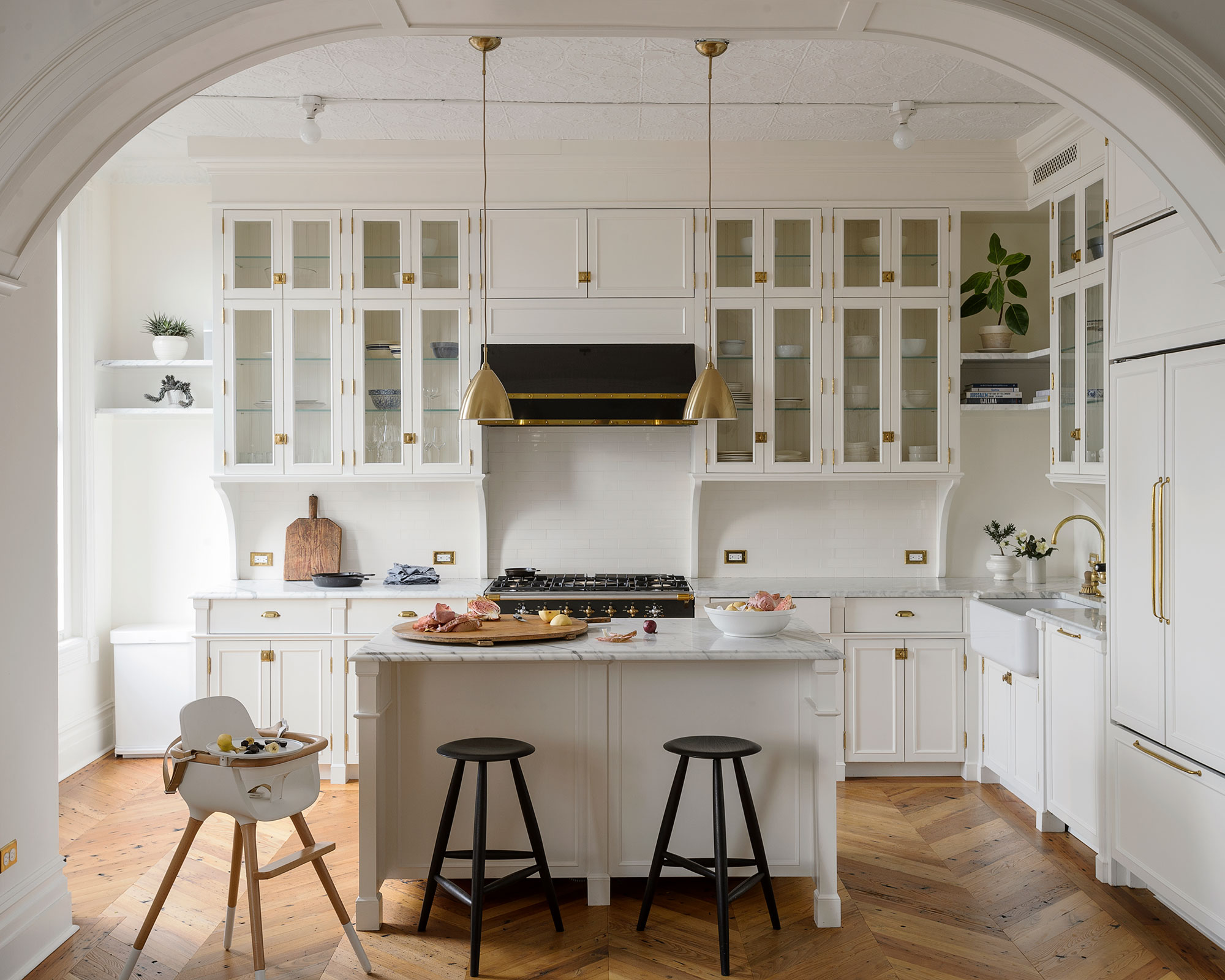
The kitchen flooring is likely to be one of the largest surface areas in the room, so its selection deserves careful thought. It needs to perform on many levels – durability, safety, and ease of cleaning – and it must look great, too, so give it as much consideration as your cabinetry.
Wood remains an enduring choice for interiors and is the ideal flooring to bring warmth and character to a transitional kitchen. Solid wood looks beautiful and is wonderfully versatile – rustic or reclaimed boards look fabulous in a transitional kitchen. With regular, correct maintenance, it’s a floor that will last for years.
This kitchen is a great example – a wooden chevron floor adds warmth to the kitchen, while white Shaker cabinets with gold hardware create a transitional balance to the space.
12. Mix in old fashioned features
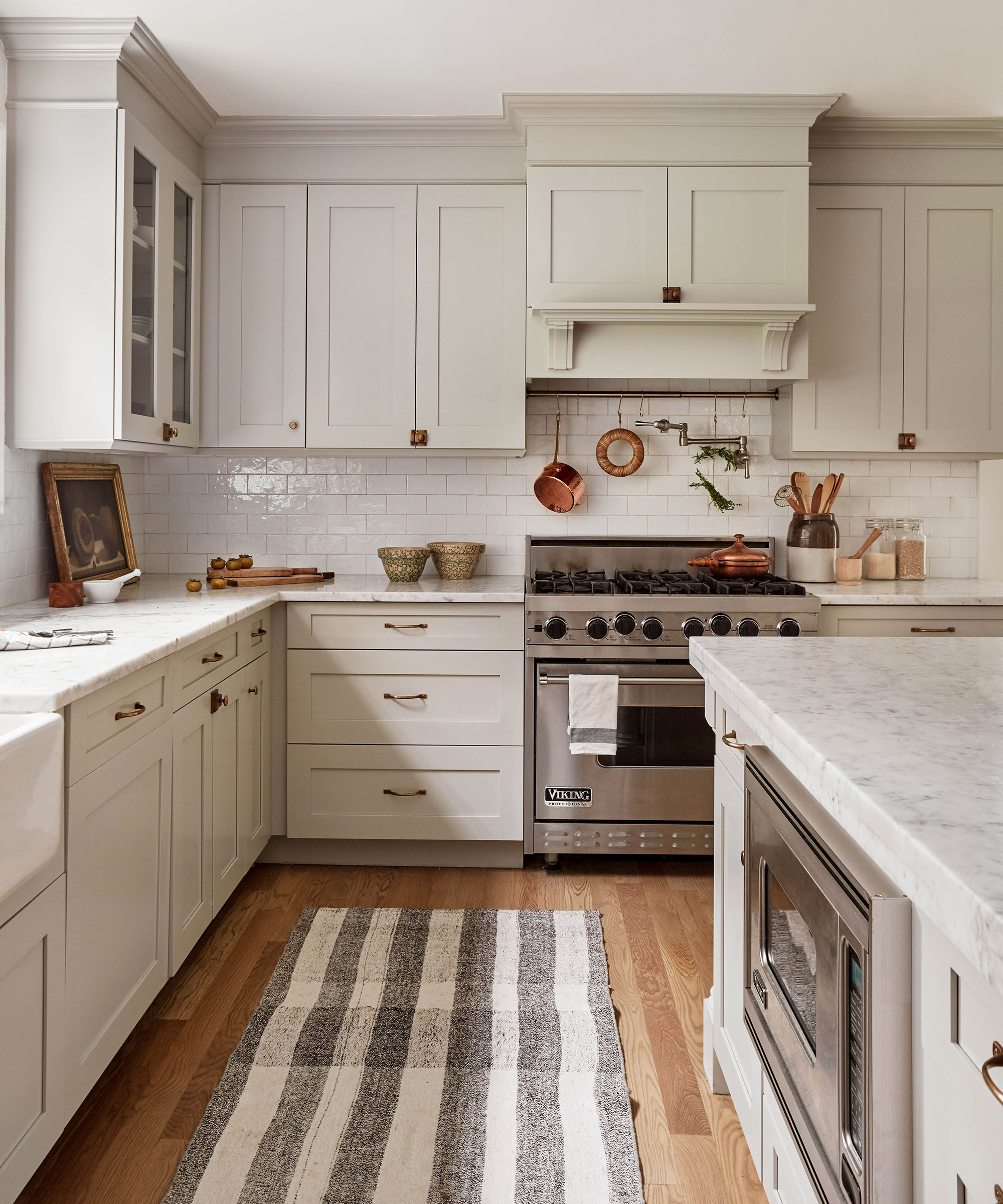
An easy way to make a modern kitchen feel more transitional is to bring in more traditional features to break up built-in cabinetry. And one such design that's making a strong comeback is the pot hanger, which is a welcome addition to a transitional design.
In this transitional kitchen, a brass pot rail has been installed above the cooker between two cabinets. It's a simple addition that adds warmth, contrast, and a more lived-in feel to the space. It's also a functional addition too, offering additional space to store pots, pans, and decorative items.
13. Soften a modern kitchen with warm brass tones
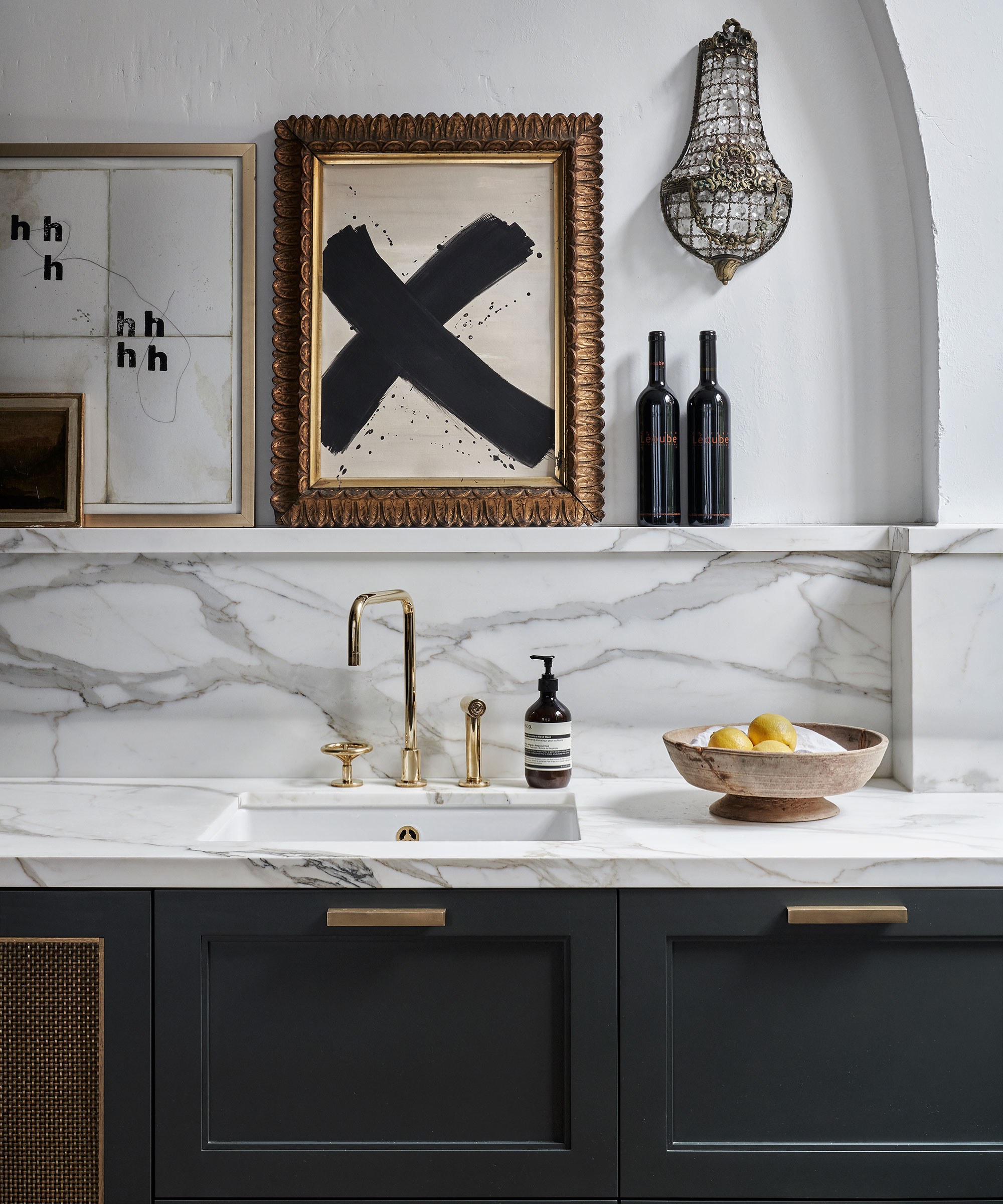
Brass is among the most timeless of finishes for your kitchen hardware, and definitely leans more classic in style. So, introducing it to your scheme is a great way to create a more transitional feel.
And we're not just talking about your knobs, handles, and faucet, either. Why not decorate with brass decor, like frames, oil crocks, and dishes, too? It's a great way to add personality to your space without cluttering the countertops.
What is a transitional kitchen?
Transitional kitchens are a style that blends the best of traditional kitchens and modern kitchens to create a space that sits somewhere in the middle.
There are usually elements from each end of the spectrum, whether it's Shaker cabinets paired with sleek marble countertops, or slab front cabinetry paired with brass hardware and rustic wooden accents.
But, above all, a transitional kitchen should feel timeless. It brings in the best of old and new, so it should transcend trends and always feel up-to-date.
What colors work best in a transitional kitchen?
Popular and versatile, transitional kitchens are a design classic. The most popular colors tend to be white and cream, but coming up fast on the outside are the new neutrals.
Shades of soft grays, warm stone, pale blues, and even butter yellow are increasing as people become a little braver with their color choices. Great on their own, these colors also work in conjunction with a bold hit of color, ochre, for an island, for instance, or dark graphite.
One of the best reasons to choose a neutral scheme is that it is easier to live with and usually less likely to feel dated than colors that are bolder. It also works well with most work surfaces and flooring, so it’s easy to update if your tastes change.
When it comes to choosing surfaces, think in tones. If you’ve chosen a darker grey color for cabinetry, you’ll find it will work well when partnered with crisp whites to add definition – paler minks and cashmeres work well with natural stone colors.
'For me, transitional design is about control. It’s about knowing when to hold back, how to layer materials, and how to let craftsmanship speak quietly. These kitchens do that; they feel timeless and fresh all at once,' says Christopher Boutlier.
Whether it's a layered lighting scheme, blend of materials, or a mix of cabinetry styles and colors, there are plenty of ways to create a transitional kitchen that feels ageless. Try to include a few timeless kitchen elements to give your design longevity, too.
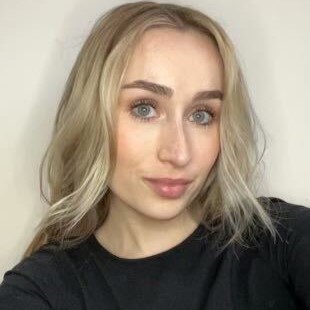
I’ve worked in the interiors magazine industry for the past five years and joined Homes & Gardens at the beginning of 2024 as the Kitchens & Bathrooms editor. While I love every part of interior design, kitchens and bathrooms are some of the most exciting to design, conceptualize, and write about. There are so many trends, materials, colors, and playful decor elements to explore and experiment with.
- Pippa BlenkinsopContributor